Menu
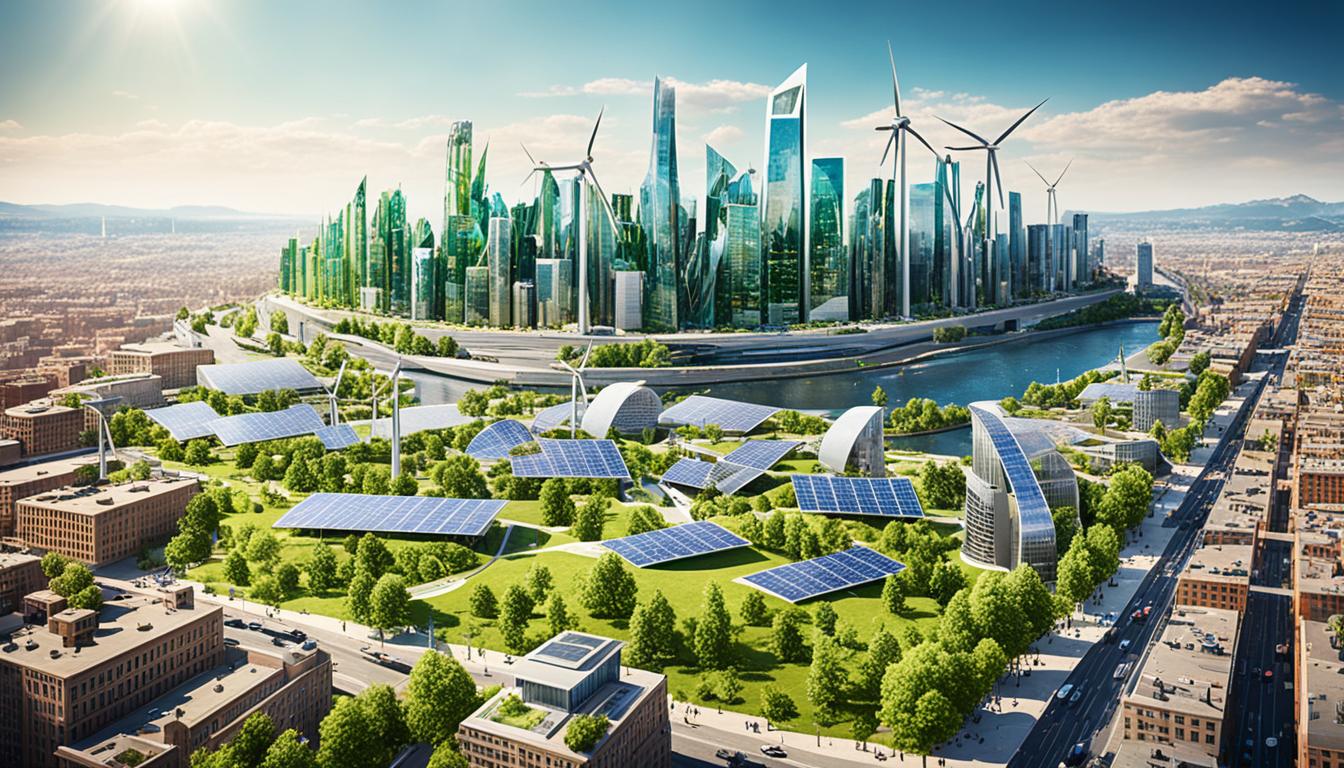
Did you know by 2050, the need for renewable energy will double the world’s demand for power? This growth highlights the urgent necessity to integrate renewable energy sources. They are essential for moving towards a more sustainable future.
I learnt a lot about this from the IRENA Insights webinars. They showed how important it is to integrate renewable systems for a greener future. The discussions focused on Africa’s energy future.
These talks underlined that careful planning and the right investments are vital. They help in overcoming common problems like wrong investments and not choosing the best projects. Also, they mentioned the significance of green hydrogen in leaving fossil fuels behind.
Another key point was the need for clear policies to boost the market. Discussions also touched on offshore wind and its future. They saw new technologies and companies pushing the sector forward.
The importance of renewable energy was clear during a fossil fuel market downturn. The benefit of renewables was more obvious. They not only help the planet but also offer good economic gains. This highlights the crucial move towards renewable energy.
More and more people are looking toward renewable energy. This is thanks to both economic growth and the aim to cut carbon use. By 2050, experts say we will need twice the amount of electricity. This will come from using more renewable sources and as the economy grows.
This effort is tied to the goal of having no net carbon emissions by 2050. To make this happen, we must invest heavily in green energy and its support systems. These investments will help us move away from non-renewable sources.
We are looking at a future where green energy like wind and solar is our main source. This could power the world by a big amount. This big change needs big investments in new ways of making and using energy.
Economic growth boosts the demand for green energy. The U.S. saw over 20% of its electricity come from green sources in 2020. That’s a big jump from earlier years. Jobs in the green sector are now more than the overall U.S. job market. Over 3 million new jobs have sprung up thanks to green energy efforts.
Putting money into green energy helps the economy. It creates jobs, makes our energy supply stable, and better for the planet.
Reaching net-zero carbon is a must. This means using a lot more renewable power by 2050. Using wind and solar, for example, to cover 35% of the U.S. electricity can cut carbon a lot.
China and India are also racing towards cleaner energy. China plans to have 1,200 GW of wind and solar power by 2026. India aims for 500 GW of green power by 2030. This is pretty ambitious.
“The global trajectory in renewable energy investment and policy frameworks highlights a strong commitment to decarbonisation goals, driving a substantial increase in renewable energy demand,” stated the McKinsey report.
Everyone is working hard to meet the carbon-cutting goals. It’s a big move towards using cleaner and greener ways to power our world.
Renewable energy is key to cutting down on carbon and reaching sustainability goals. However, they come across big hurdles. These need solutions to fit well with our current power lines.
One stumbling block is not having enough network. Our grids can’t keep up with the more we need from renewables. Just 12% of US energy was from renewable sources in 2020. The need for better setups is clear. With renewable energy use expected to grow by 2050, sorting this out is key for the renewable power grid.
The International Energy Agency (IEA) pushes for 70% of electricity to come from variable renewables by 2050. Places like Australia and California have faced issues because of too much of this kind of energy. This shows we must fix our networks to handle more renewables.
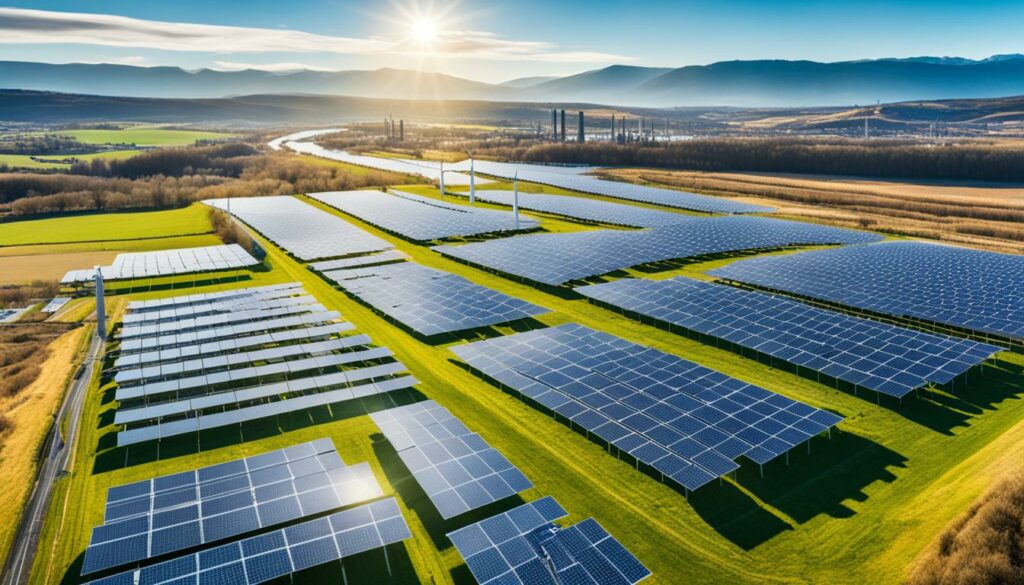
There’s also the challenge of managing in real time. Our networks were set up for steady energy sources. But with renewables that come and go, we face problems. This can cause the grid to be less stable.
We need new ideas to change these old systems. Investing in tools that manage networks better can make a huge difference. If we change how we manage the network by 35%, we could cut carbon by 45%.
Better network management can also bring more jobs in renewable energy. In 2022, the energy sector created more jobs than any other. This shows how managing our networks better helps both the planet and our job market.
To handle the changing nature of renewables, utilities need to move from being inactive to being active. Doing this really improves how reliable and stable our renewable power grids are. This is key for using more renewable energy.
To sum up, fixing network issues and managing them better in real time are crucial. Warming up to a more flexible renewable energy management system is where we need to go. This will let our renewable power grid grow in a way that lasts.
When we think about the world’s shift to cleaner energy, we must plan for the long run. This includes making strategies to use less harmful energy. IRENA talks a lot about how this planning is key. It helps us meet climate goals and make smart energy choices without wasting money.
Looking ahead to the future, we need to plan how to use energy wisely. Long-term energy plans are important for guiding us towards a cleaner future. The 2022 World Energy Transitions Outlook shows us the steps needed to reach clean energy goals by 2030. With solar and wind power getting cheaper, these plans are more doable.
Helping the planet by using less polluting energy is critical. Yet, not enough money from the G20’s big budget was spent on clean energy in the past years. We must use these long-term energy plans to meet the Paris Agreement targets. Making wind power cheaper is also pushing us to choose clean energy more.
Keeping up the current pace of the energy shift is essential to fight climate change. The International Energy Agency expects renewable energy to grow a lot by 2024. So, we really need smart, long-range plans and strong clean energy strategies. This is our best way to have a sustainable, clean energy future.
In short, having clear long-term energy goals and low-pollution strategies is key. It helps countries reach their clean energy aims and supports a strong, clean change.
It’s important to use sustainable energy solutions for a better future. Putting Building-integrated photovoltaics (BIPV) into buildings makes them look better and produce more energy. This changes buildings into places that make solar power. It’s a big step in adding more renewable energy in cities.

Solar thermal systems (STS) help by giving us heat, cool air, and hot water. They make us less dependant on usual energy sources. Using the right materials shows we care about the planet. Materials like wood, bamboo, and natural fibres are great because they last long and come from nature.
Using methods to make less waste is also key. Things like prefabrication and modular construction cut down how much rubbish is made during building. This saves time and money. Technologies that store extra energy are also important. They help keep power going, which makes our clean energy work better.
Some buildings are already doing an amazing job at being sustainable. The Bullitt Center in Seattle uses the wind and the sun to keep itself comfortable. Its windows are made to let in just the right amount of heat from the sun. The Bank of America Tower in New York is a great example too. It saves water, has gardens on its roof, and uses energy wisely.
In the future, we will see more buildings that hardly use any energy. They will mainly use power from the sun and other renewable sources. This is a big chance to meet the energy needs of businesses in a green way. It’s all about moving towards a future where we use energy well and protect our planet.
| Technology | Application | Benefits |
|---|---|---|
| Building-integrated photovoltaics (BIPV) | Commercial Buildings | Enhanced energy production and aesthetics |
| Solar Thermal Systems (STS) | Heating, Cooling, Hot Water | Reduced reliance on conventional energy |
| Sustainable Materials | Commercial Construction | Improved sustainability and biodegradability |
| Energy Storage Technologies | Grid Resilience | Continuous power availability |
| Prefabrication and Modular Construction | Building Construction | Reduced waste and construction time |
Clean energy is leading the shift towards renewable power. Innovations like offshore wind energy and green hydrogen are key. Countries worldwide are investing heavily in these technologies to create strong renewable energy systems.
The growth of offshore wind energy is impressive. Many countries are pouring money into it. For instance, Norway is putting NOK 2.5 billion in 2022 towards improving offshore wind. The UK has committed GBP 4.5 billion from 2022-2025 for its development, part of its plan to achieve net zero. This shows a global push towards more efficient offshore wind energy.
Green hydrogen is key to the future of clean energy technologies. It’s a green alternative for tough-to-decarbonise industries. India, for example, is keen on it, planning to spend INR 19 billion from 2023-2030. Austria is also investing EUR 100 million by 2026. This mirrors a global interest in green hydrogen.
Not to be left behind, Canada is putting CAD 8 billion in its Net Zero Accelerator Initiative to support green hydrogen. Green hydrogen will not only help industries be cleaner but also boost international trade. By putting money into clean energy technologies, countries are working towards a greener future with green hydrogen at its core.
| Country | Investment Amount | Purpose |
|---|---|---|
| Australia | AUD 100 million (2022-2026) | Critical minerals projects to support clean energy supply chains |
| Austria | EUR 100 million (2022-2030) | Pilot and demonstration projects for hydrogen production and innovation |
| Canada | CAD 8 billion (2020-2030) | Decarbonising heavy industry, hydrogen, batteries |
| France | EUR 2.6 billion (2022-2030) | Clean energy innovation and industry development in renewables |
| Germany | EUR 3 billion (2022-2030) | Energy-Climate Fund for domestic battery supply chains |
| India | INR 19 billion (2023-2030) | National Green Hydrogen Mission for R&D and pilot projects |
| Japan | JPY 67 billion (2023) | Research in nuclear power and spent fuels treatment |
| Korea | KRW 500 million | Development of core hydrogen technologies |
The renewable power grid is key for our move to sustainable energy. It uses sources like solar and wind with storage. This mix is vital for strong, dependable energy setups, especially far from cities or in emergencies.
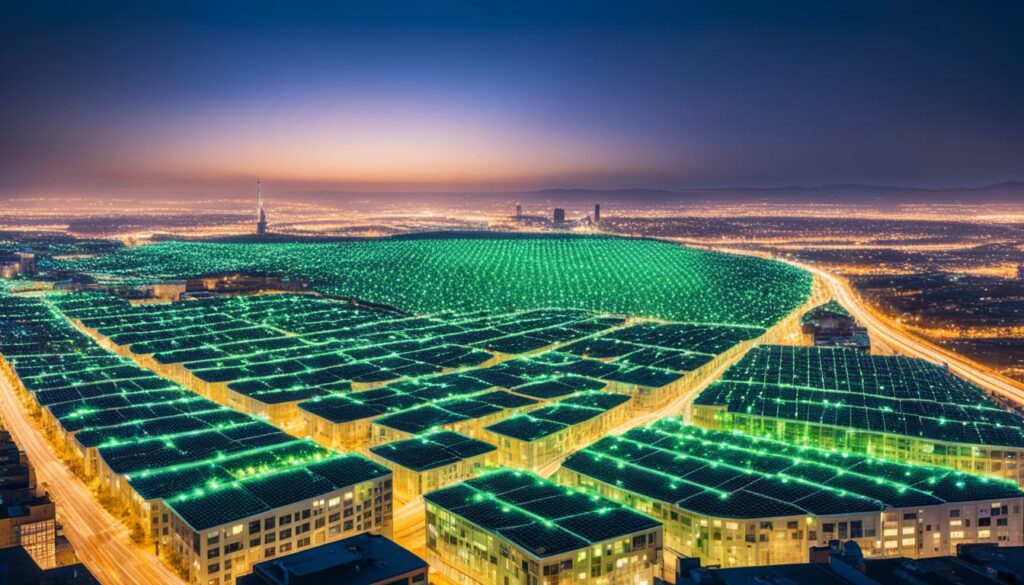
Getting renewable grids to meet our energy needs is complex but vital. At NREL’s ESIF, smart tech helps balance energy supply with demand. This supports crucial grid integration work.
In remote areas, microgrids are being used, thanks to the ADMS. This system makes grids tougher, able to handle more. It tests real-life grid problems, teaching us how to do better.
Matching renewables with our power needs is a big challenge. Solar and wind’s ups and downs can make power unreliable. We need new ideas to keep our grids steady and working well.
NREL is working on smart solutions, like IT systems and tech for big batteries. These help make power grids more reliable. They even help people see how batteries work best, and which ones are worth it.
With global power needs set to jump a lot in the next few years, we must act fast. Adding renewable power to our grids needs big investments. It also calls for clever ways to keep our grids running smoothly.
Using AI and smart data can help a lot. They can support more renewable energy on our grids without the lights going out. It’s all about keeping the power strong and steady for everyone.
The world is moving towards using more renewable energy. To manage this change well, we need smart plans. Integrated grid planning is a key part. It helps keep our energy systems stable and efficient for the future.
Planning how we use energy grids is vital with more renewables. The demand for electricity will rise a lot soon. An integrated plan looks ahead at needs, the weather, and things that might go wrong. This makes sure the grid can handle more green energy and stays strong.
By 2030, almost half of our power could come from renewables. And by 2040, it could be as much as 70%. This quick change shows we need to blend green energy into our grids fast. A solid plan can solve the problems of old grids struggling with new demands.
Using digital network models is key in our journey. They use AI and smart data to help us make better choices. These models also predict what energy we’ll need and what we can make. They are important for making our grids steady, even with different kinds of green power.
These models are also great at fixing grid problems. They make sure the grid can cope with ups and downs from renewables. To prepare our grids for the future, we need to invest a lot in them by 2030. Around €550 billion every year is needed for this.
Grid operators have to change how they plan, too. They should set clear rules and options for people using renewable energy. This speeds up the process and cuts down on waiting times.
Using high-tech models and smart planning is how we can make renewable energy work well. Mixing these new ways with what we already know can make our energy systems strong. This way, we can count on green energy to power our world.
Looking ahead to the future of renewable energy, big steps have already been taken, and more are coming. In 2023, the global capacity for renewable energy soared by 50%. Three-quarters of this expansion came from solar energy. This growth underlines the key role of renewables in moving towards clean energy.
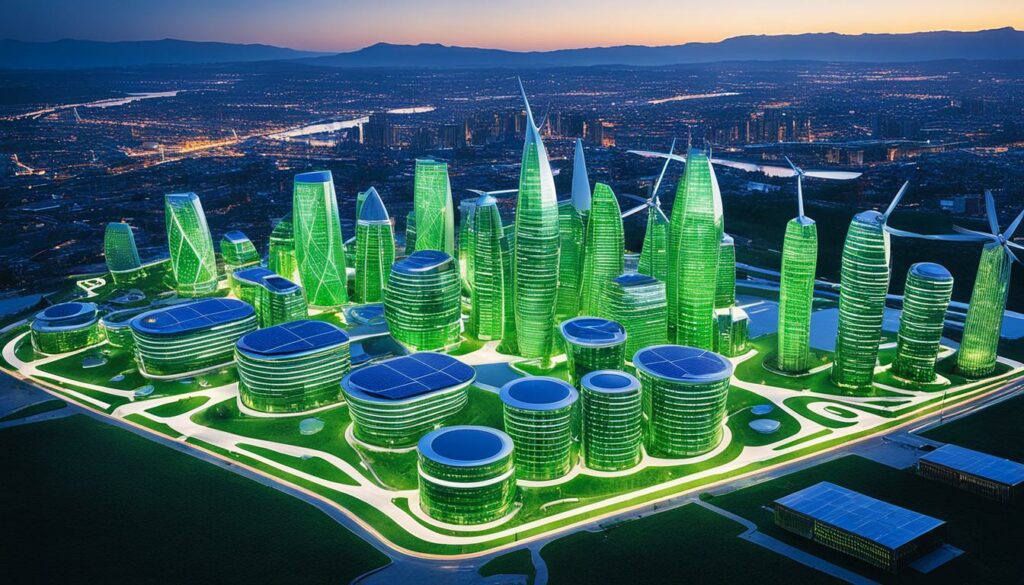
The cost of solar power has dropped by 90% in the last ten years. This fall is due to cheaper materials and better ways of installing solar panels. And this trend keeps getting better. Forecasts say there will be a 7,300 gigawatt rise in renewable energy capacity from 2023 to 2028. Solar PV and onshore wind will do a lot of the heavy lifting. By 2028, wind power could more than double, hitting 350 gigawatts.
China saw a 66% jump in its renewable energy in 2023. The White House plans to have 30 gigawatts of floating offshore wind power by 2030. This move will offer clean energy to 10 million more homes and cut energy bills. Plus, it will create many jobs in the sector, boosting clean energy’s move forward.
Companies like Omega Energia are making a difference too. Omega is doing better at guessing wind and solar power levels. Still, hydro power is expected to be the biggest source of clean energy up to 2030. It will help keep a steady supply of green energy.
Investment and policies are also very important. For example, the Inflation Reduction Act could lead to more than 48 gigawatts of wind energy being revamped. And tax breaks for offshore wind could help 14,700 miles of coastal communities. Progress isn’t stopping there. There’s also work into making geothermal systems better and using new biofuels. These efforts aim to cut jet fuel emissions by as much as 80%.
The table below gives a quick look at some significant plans for renewable energy:
| Region | Key Developments | Expected Impact |
|---|---|---|
| Global | 7,300 GW increase in renewable capacity by 2028 | Substantial boost in clean energy usage |
| China | 66% market increase in 2023 | Dramatic enhancement in renewable capacity |
| USA | 30 GW of floating offshore wind power by 2030 | Clean energy for 10 million additional homes |
| Global | Hydro as the largest clean energy provider through 2030 | Stable, large-scale clean energy supply |
These numbers and plans show our growing reliance on renewable energy. The future will see more advanced and connected renewable energy setups. These developments are key in meeting our energy needs without harming the planet. They also steer us towards achieving global green goals.
Integrating renewable energy into existing systems needs a careful balance. This means managing how much energy is produced and used. It also requires strong rules to follow. The key is to have effective renewable energy management strategies.
Providing enough power while using lots of renewable energy requires flexible systems. The ability to quickly match what is produced with what is needed stops chaos. Ways to do this include better predicting energy needs, simulating how systems will work, and using advanced storage like lithium-ion batteries.
Moving towards net-zero could generate a million new U.S. jobs. It shows that focusing on renewable over fossil fuels creates more employment benefits.
Also, getting 35% of U.S. electricity from wind and solar might cut emissions by 45%. This proves benefits for both the environment and the economy.
Regulations play a huge role in the success of renewable energy. They set clear paths for investment and new ideas in the renewable sector.
In 2020, the U.S. hit 12% of its energy from renewables. But to get more, better policies are needed. The goal to be fully clean by 2035 makes the role of these rules clear.
Challenges like where resources are and how fast current systems can change need special attention. The answer lies in policies that make grids more flexible and build new infrastructure for various renewable sources.
Renewables not only cut carbon but also encourage energy systems spread out over many places. This makes our energy setup stronger and more adaptable.
| Statistic | Details |
|---|---|
| US Renewable Energy Consumption (2020) | 12% |
| New Jobs in Renewable Sector (2022) | 3 Million+ |
| Carbon Emission Reduction via Wind & Solar | Up to 45% |
| Renewable Energy Employment Benefit | 2x more jobs per $1M investment compared to fossil fuels |
| US Clean Electricity Goal | 100% by 2035 |
| Net-Zero Economy Job Increase | 1 Million jobs |
Investment in renewable energy is growing fast. More money is going to clean projects worldwide. The US Federal Energy Regulatory Commission and the US Energy Information Administration’s data show this. This shift highlights the world’s aim to use more clean energy and less oil.
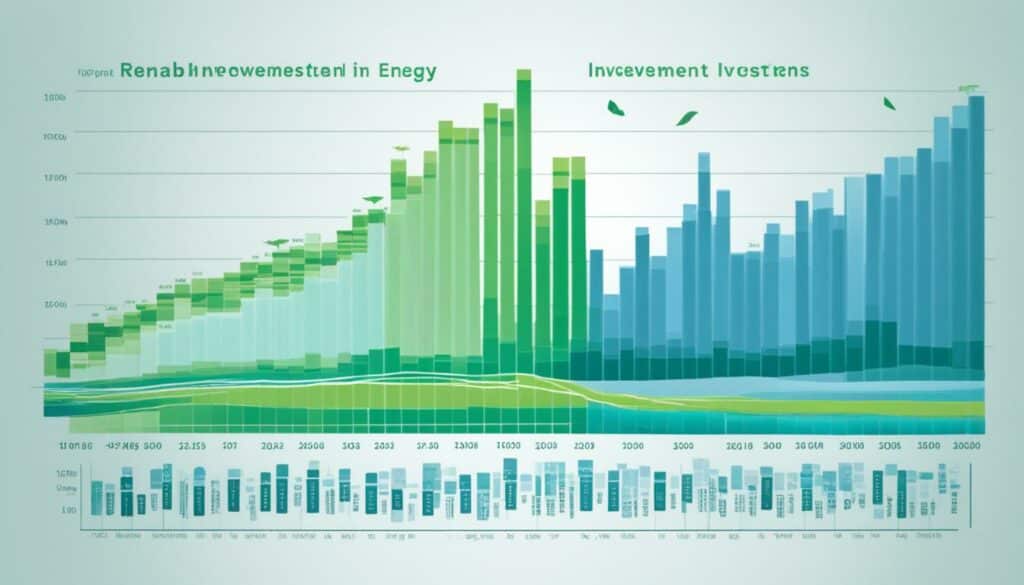
There’s a big focus on clean energy worldwide. More funds are going into solar and wind projects. The International Energy Agency says the costs of solar and wind have dropped. This makes investing in clean energy more attractive.
Additionally, lower commodity prices are helping. They balance out the high cost of borrowing. These changes make renewable energy technologies cheaper to invest in.
| Year | Clean Energy Investment (USD trillion) | Fossil Fuel Investment (USD trillion) |
|---|---|---|
| 2021 | 1.7 | 1.2 |
| 2022 | 1.9 | 1.3 |
| 2023 | 2.0 | 1.4 |
These trends show why we need more renewable energy. In the US and Europe, many wind and solar projects are waiting to be finished. This shows how much people want and need renewable energy.
Public money is key in renewable energy growth. Brazil got $70 million to boost green hydrogen. It aims to attract $9.1 billion more by 2030. This shows how important public money is for boosting private investments.
Every year, $770 billion goes to clean energy in new markets. But, only a little of this is for the electricity grid. It’s very important to spend more on the grid to meet climate goals and provide stable energy.
The use of new money strategies is vital, says SEPA. The IEA also says public money is crucial to fix the investment gaps and keep renewable energy growing.
In short, knowing about investments and public money is crucial for renewable energy’s success. With the right approach, we can tackle the challenges and seize the opportunities in clean energy.
Looking at renewable energy costs, we see a big drop in prices. From 2010 to 2020, the cost of solar power fell by 85%. Onshore wind costs decreased by 13%, and offshore wind by 9% during this time.
These price drops are key in making renewable energy more affordable. Especially in new markets, like some emerging countries. Here, adding 534 GW of renewable power ended up cheaper than using fossil fuels. This saved around USD 32 billion in electricity costs.
The move to clean energy is also creating a lot of jobs. In 2022, over 3 million new jobs were in renewable and green energy. The U.S. thinks it could add another million jobs by becoming a net-zero country. This would be a big win for job seekers.
Choosing greener energy is good for the planet and our health. If 35% of U.S. electricity came from wind and solar, it could cut carbon by 45%. This would help stop hundreds of thousands of early deaths caused by bad air.
To wrap up, renewable energy is more affordable because of tech improvements and getting bigger. The U.S. wants to use 100% clean power by 2035. As costs keep dropping, this goal becomes more achievable. Changing to cleaner energy brings good for the environment and the economy. It clearly shows the many benefits of switching to renewable energy.
| Energy Source | Cost Reduction (2010-2020) | Global LCOE Decrease (2020) |
|---|---|---|
| Utility-Scale Solar PV | 85% | 7% |
| Onshore Wind | 13% | 13% |
| Offshore Wind | 9% | 9% |
Renewable energy markets worldwide are growing fast. This is thanks to new technologies and solid support from policies. In this study, we focus on the geothermal energy market. We’ll look at its current state and make predictions based on its growth trends.
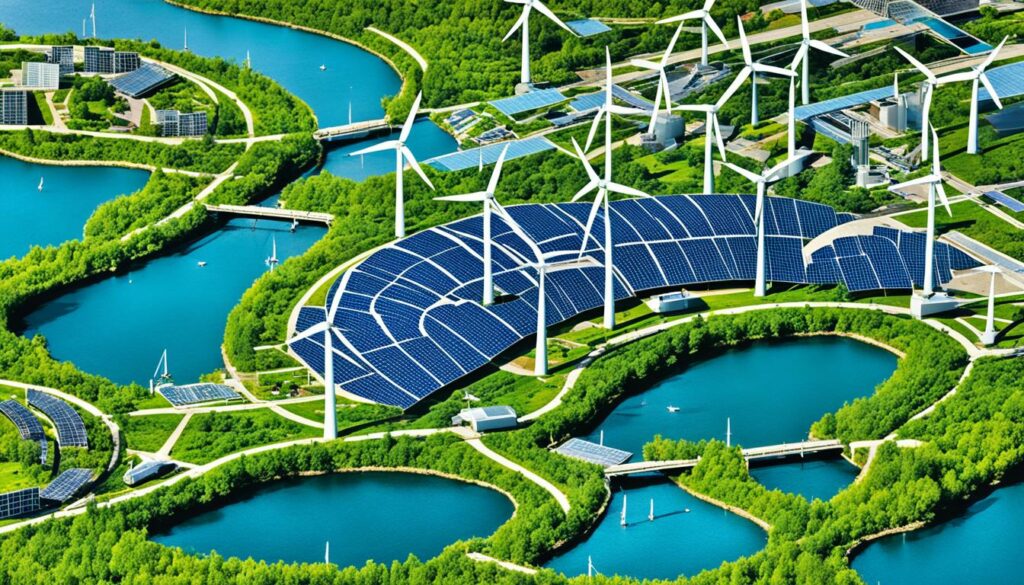
The geothermal energy sector is gaining importance globally. The International Renewable Energy Agency notes strong growth, especially in the western US, Indonesia, and the Philippines. New tech, like Enhanced Geothermal Systems (EGS), is changing the game. It lets us extract heat from deep under the Earth’s surface. This, along with better binary cycle power plants, shows the geothermal market’s big potential.
Projections show that renewable energy will continue to grow. SEPA’s 2030 Club sees more hydrogen coming to the EU. This will help the hydrogen market boom. There’s also good news in wind energy. The Inflation Reduction Act has earmarked over 48 GW for update. These moves are part of a larger trend. The Clean Energy Buyers Alliance sees more and bigger investments in renewable projects.
Looking at the solar sector, reports from Wood Mackenzie show a lot of action. There’s been a major increase in funding, with a lot of mergers and acquisitions. The market appears very active and is likely to keep growing.
| Region | Wind Capacity (GW) | Investment ($ Billion) | Key Drivers |
|---|---|---|---|
| North America | 48 | 60 | Inflation Reduction Act, BOEM approvals |
| Europe | 55 | 75 | Renewable Hydrogen Imports, CEBA Deals |
| Asia Pacific | 70 | 95 | Solar Funding Growth, Regional Policies |
Electricity demand will rise by 40% from 2020 to 2030. At the same time, renewable energy systems (RES) will increase nine times by 2050. This makes grid stability very important. We need new ideas to handle the large growth in clean energy and keep our energy networks strong.
To reach net-zero emissions by 2050, countries must invest more, up to €550 billion, in their energy grids by 2030. But, current planning tools are not fast or flexible enough for the growing clean energy sector. We can make our grids work harder without building more by using smart digital tools. For instance, by using better ways to understand how much power our lines can carry, we can use our existing infrastructure better.
Using advanced methods to calculate possible issues with renewable energy, grid designs, and electric cars helps us manage risks well. Making clear rules for connecting to the grid helps customers know what to expect. This is key to keep our energy networks stable as we add more green power.
Countries with lots of hydropower, such as Norway, are naturally better at handling grid stability. But even they face challenges. For places like Italy and Ireland switching from coal to renewables, the journey is harder. They need big, heavy devices like rotating stabilisers to help keep the grid steady.
Two large battery parks were built in the Republic of Ireland by Statkraft in 2020-2021. They play a crucial part in making the grid more stable. These parks can power the area for up to 30 minutes now, but could go up to four hours soon.
The U.S. also has its share of grid stability issues, with big weather and cybersecurity threats. Places like California and the Southwest must be especially careful in balancing their electricity use with renewable supplies. The U.S. government and private companies are working together to make the grid stronger for the long run.
To sum up, solving the issues around clean power and making our energy grids stable needs a mix of new ideas, smart digital tools, and big investments. With these steps, we can build a future that runs on reliable, green energy.
Integrating renewable energy into the power supply is crucial now. By 2030, we expect a 40% rise in electricity demand. It’s important to fix current issues for this surge.
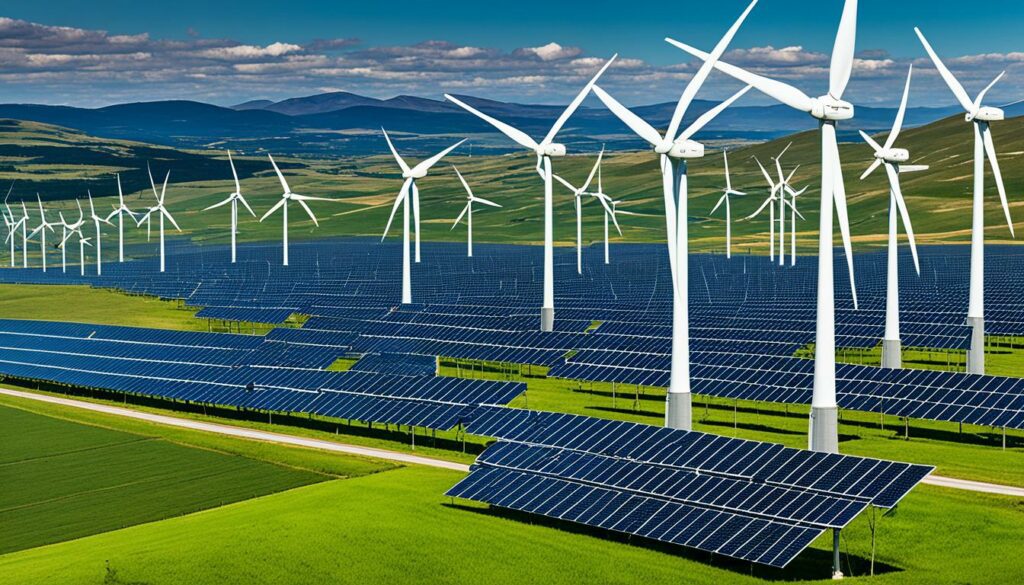
To speed up grid connection, we must optimise needs. This includes precise ways to figure out how much new power the grid can host. We use smart analysis and solid plans to make this happen. Better methods mean we can connect new sources faster. It also helps the existing grid work better.
Automating grid tasks is key for adding more renewable energy smoothly. It helps with connecting systems and managing the grid in real time. This way, the grid can react quickly to changes, keeping the system stable. Automated tools also help those in charge work together better. Especially when handling the ups and downs of solar and wind power.
In summary, we aim to make setting up renewable energy quicker. This way, our energy grid will be ready for whatever comes, making it more reliable.
Transitioning to renewable energy has huge benefits for our world and our wallets. It cuts down our need for fossil fuels and boosts the economy. This transition helps our planet and makes economic sense for today’s world.
In 2020, renewable energy made up 12% of all energy used in the U.S. This shift is growing, reducing our reliance on things like coal and oil. The country aims to be using 100% clean energy by 2035. The goal is to reach zero harmful emissions by 2050 with the help of renewables.
If we can get 35% of our electricity from wind and solar, we could lower carbon emissions by up to 45%. This is a big win for the environment. Moving towards renewable energy will also save many lives by improving the air we breathe. This change shows how important moving from fossil fuels is for health and our planet.
Renewable energy not only helps the environment but also boosts the economy. The U.S. going net-zero is set to create a million new jobs. This jump in job opportunities is impressive, especially in the renewable energy industry.
This change is good for local communities too. Investing in renewable energy produces three times more jobs locally than investing in fossil fuels. In one place in Iowa, every dollar spent on goods creates nearly two dollars in economic activity. Another example is that solar energy plants in California bring in twice the tax money as gas plants.
| Investment | Impact on Jobs | Tax Revenue |
|---|---|---|
| Fossil Fuels | Up to 1 Job Created | Lower Tax Revenue |
| Renewables | Up to 2 Jobs Created | Higher Tax Revenue |
Choosing to invest in renewable energy is a smart economic move for America. It builds jobs and helps secure our energy future in the long run.
Looking at how we’re adding renewable energy shows it’s a big project. We need help from many fields to make it work. This move to cleaner energy is not just about fixing technical problems. It’s also about money matters and how to invest wisely. Plus, we must have rules in place that help switch to cleaner energy smoothly.
My studies have shown that using green energy can really cut down on CO2. This happens by using wind, solar, and other clean sources instead of coal or oil to make electricity and power cars. Making more clean power could bring its cost down, making it a better choice. But we still need better ways to store this power.
The future of power looks to use more renewable energy in smart ways. This means we’ll see things like community power systems grow, especially in smaller areas. But places that are still developing may struggle more with these new energy ideas. They need special plans to make it work for them. To keep the power system working well, using the latest tech and smart ideas is key.
Getting to a future with smarter, cleaner energy needs a lot of planning and new ideas. As more places around the world turn to renewables, they face their own challenges. Tackling the ‘Grid of the Future’ will be different for each country. But with everyone putting in the effort for clean energy, we can make it happen.
The goals of using more renewable energy are clear. It aims to make our energy cleaner, decrease harmful emissions, and secure our power supply better. This is done by adding renewable sources to our current energy mix.
Growing economies need more energy. They also push for cleaner power sources. This leads to an increase in the use of renewable energy. It helps meet the extra energy needs while cutting down on harmful air pollution.
There are two main challenges. Our current energy grids can struggle to cope with the increasing demand for renewable power. Also, as these sources can be less predictable, we need better ways to manage them in real time.
Looking at energy issues globally is vital. It brings together efforts to plan for the long term and cut down on emissions. This way, we can work towards a sustainable energy future together. It also helps us follow international agreements on climate action.
Planning ahead, using new ideas, and working together are key. By doing these things, we can solve the problems that come with adding more renewable energy. This makes our energy systems strong and ready for the future.
The future relies on new wind and hydrogen technologies. Better offshore wind ways and trends in hydrogen show how we are moving forward. These are essential for cutting pollution in hard to change industries.
A grid of renewable power does a lot. It combines different clean energy sources and solves technical challenges. This ensures we can switch to green power without losing stability or reliability.
Integrated planning and the use of digital tools are crucial. They let us predict what we need and balance our energy use. Mixing these with smart technology helps keep our energy system working smoothly.
The future of clean energy looks very connected and high-tech. It’s designed to meet the world’s growing power needs while keeping our air clean. These goals are set to reduce harmful gases in the future.
To balance power needs, we need good rules, smart technology, and expert energy management. These keep our power system stable and eco-friendly. They also help us use renewable energy smoothly.
More money is going into green projects around the world. Public support is also key, bridging financial gaps and meeting big energy changes. This helps shift our energy use towards more sustainable options.
Even with materials costing more, renewable electricity has become cheaper worldwide. This shows that renewables can stand up against fossil fuels. They offer both secure energy and a way to cut pollution.
Energy markets look different depending on where you are and what technology you use. Sectors like geothermal power are growing fast. Reports guide us on what’s making this change happen, helping the world use more green energy.
To get a stable grid, we can find new ways to use what we already have without building more. Digital tools help us manage risks better. Using smart checks on power lines helps us use our network more effectively.
Making connections better and automating checks can speed things up. Energy companies can fix problems faster, make better use of power lines, and connect new green power sources quickly. This helps grow our renewable energy use.
Using more renewable power means we rely less on polluting fuels. It saves a lot of money in the long run for both making power and keeping the environment healthy. This is good for everyone.